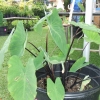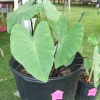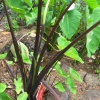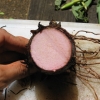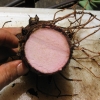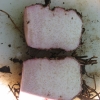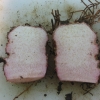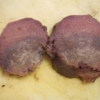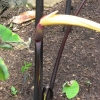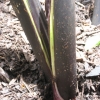Use As Food
Mainly as a table taro. Taro of Lauloa group were used by the early Hawaiians for medicinal purposes, chiefly in pulmonary disorders. They are now popular mainly as table taros and for poi.
Distribution
Planted fairly extensively in the uplands throughout the islands but especially so in Kona, Hawai‘i.
General Characteristics
Tall, erect, stocky, maturing within 9 to 12 months, producing from 5 to 10 ‘ohā; recognized by purplish marginal veins on leaves and greenish edges of purplish-black Hā (Petiole).
Ha (Petiole)
100 to 140 cm. long, purplish-black with fairly distinct light green edge, a dark red ring at kōhina (base) with light pink for 1 to 2 cm. above.
Lau or Lu'au(Leaf Blade)
40 to 60 cm. long, 30 to 40 cm, wide, 35 to 45 cm. from tip to base of sinus (māwae), arrow head shaped, slightly concave (curve inward), dark green; margins with a few large undulations, the marginal veins purple; piko small, purplish; round leaf section (lobes) obtuse with narrow lihi māhae (sinus).
'I'o kalo (Corm)
Flesh white, tinged with pink especially near the top (apex), with yellowish fibers; skin light to brilliant dark pink and occasionally purple along leaf-scar rings.
Pua (Flower)
Hā (peduncle) purplish-black; flower cover (spathe) 30 to 35 cm. long, usually curved and drooping, the lower tubular portion 5.5 to 6 cm. long, clark reddish-purple, the upper portion orange with reddish-purple margins, usually tightly rolled but sometimes slightly open near constriction (skinny part of flower).
Remarks
This variety resembles Lauloa ‘Ele‘ele ‘Ula very closely. Although the outward appearance is almost identical, the two varieties may be differentiated by the greenish edge (‘Ōma‘o) and continuance of the Hā (Petiole) color into the leaf veins of Lauloa ‘Ele‘ele ‘Ōma‘o in contrast to the more pinkish edge and the changing of the dark Hā (Petiole) color to a yellow green just below the apex of Lauloa ‘Ele‘ele ‘Ula.




